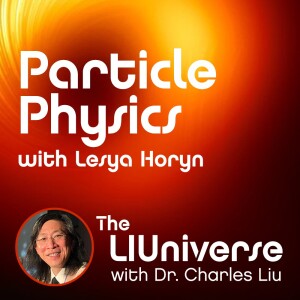
Saturday Jun 24, 2023
Particle Physics with Dr. Lesya Horyn
What is the universe made of? Will we ever have a complete list of all the particles that make up existence? To find out, Dr. Charles Liu and co-host Allen Liu welcome Dr. Lesya Horyn, PhD, a Fermilab researcher working at the Large Hadron Collider (LHC) at CERN in Switzerland.
As always, though, we start off with the day’s joyfully cool cosmic thing, which takes us to Brookhaven National Laboratory in Long Island, NY, where scientists have figured out how to make matter from energy. They smashed 2 photons together to produce a matter/anti-matter particle pair. It happens naturally in the universe, and we convert matter into energy all the time, but we’ve never before turned energy into matter using photons, which have no mass.
Next up, a quantum mechanics question from Lindsey in Massachusetts: “Do you believe that there is an elementary particle responsible for gravity?” Dr. Horyn explains how the standard model (the “periodic table” of subatomic particles) “makes a nice picture” but is “missing stuff” like dark matter and gravity, neither of which are in the standard model. One of these missing pieces is the graviton, a theorized elementary particle that would be responsible for gravitational force in the same way that the photon is responsible for the electromagnetic force, which Dr. Horyn and Charles both believe exists but has not yet been discovered. (Honorable mention: Our geek-in-chief Chuck mentions the Marvel Comics supervillain Graviton, who has the comic book superpower of gravity.)
Dr. Horyn explains her research at CERN, and how the LHC actually is used for experiments. You’ll learn more about the LHC, a 17-mile-circumfrence underground ring used to smash particles into each other at specific speeds, and the Compact Muon Solenoid (CMS) detector, which Lesya is using for her research now. You’ll also hear about the much larger A Toroidal LHC Apparatus (ATLAS), which she used previously for her primary research, both of which were used in the discovery of the Higgs boson ten years ago.
As Charles and Lesya take us down the particle physics rabbit hole, we end up talking about the Muon g-2 experiments eventually conducted by Fermilab. Find out why the gyromagnetic moment is important to particle physics – and yes, we go deep into the physics weeds in this episode! (Make sure to catch the story about moving a giant magnet from Brookhaven National Laboratory in New York by boat and truck to Fermilab in Illinois!)
Moving on, the crew tackles a question from Walter T. on Patreon, who asks, “Could the many worlds theory still be deterministic?” Charles explains the many worlds model, but because our existing experiments cannot distinguish between the many different models of quantum mechanics, Lesya defaults to the infamous Richard Feynman quote, “Anybody who claims to understand quantum mechanics is either crazy or lying.”
If you’d like to know more about Dr. Horyn, you can follow her on Twitter at @lesyaah. And be sure to follow @CERN, @ATLASexperiment, and @CMSexperiment to keep up with some of the developments we’ve discussed in this episode.
We hope you enjoy this episode of The LIUniverse, and, if you do, please support us on Patreon.
Credits for Images Used in this Episode:
Brookhaven National Laboratory – Credit: Energy.gov, public domain
Particles in the Standard Model – Credit: Cush via Wikimedia, public domain
The CMS detector – Credit: Evenkolder, CC-BY 2.0
The g-2 experiment magnet in transit – Credit: Energy.gov, public domain
MuonG-2 Predicted – Credit: Allen Liu, for the LIUniverse
MuonG-2 Observed – Credit: Allen Liu, for the LIUniverse
No comments yet. Be the first to say something!